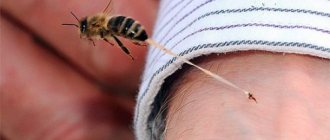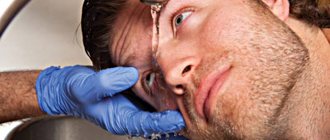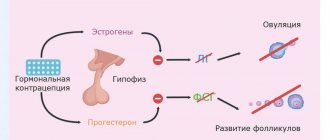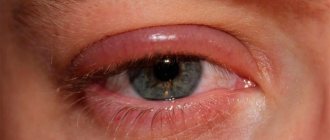GENERAL INFORMATION ABOUT TICKS
Ticks are characterized by seasonality.
The first cases of attacks are recorded in early spring, when the air temperature rises above 00 C, and the last cases - in the fall. Peak bites occur from April to July. Bloodsuckers do not like bright sun and wind, so they lie in wait for their prey in damp, not too shady places, in thick grass and bushes.
During the bite, the parasites inject an anesthetic substance, like mosquitoes, so the suction goes unnoticed. Favorite places to bite are the neck, the area behind the ears, armpits, groin area, and elbow creases.
Attention. Not all ticks carry diseases. But even sterile parasites, and there are 85–90% of them, can cause allergic reactions.
The parasites are not picky when choosing a hunting object; they bite everyone who gets in their way - birds, small and large animals, humans.
TICK ATTACK AND BITE
If the tick is a carrier of encephalitis, the pathogen is concentrated in the salivary glands of the bloodsucker and enters the victim’s body at the time of the bite. Therefore, even immediate removal of the attached parasite does not reduce the risk of infection. In the case of Lyme disease, the virus accumulates in the tick's gastrointestinal tract and enters the body when it begins to feed, that is, 5-6 hours after sucking. In this case, early removal of the parasite can prevent infection.
Redness of the skin at the site of the bite does not indicate infection. The color change may appear due to allergies or the presence of the parasite in the victim’s body for many hours. If such symptoms appear, it is better to consult a doctor.
With borreliosis, a tick bite looks like focal erythema up to 20–50 cm in diameter. The shape of the inflammation is most often regular, with an outer border of bright red color. After a day, the center of the erythema turns pale and acquires a bluish tint, a crust appears and soon the bite site is scarred. After 10–14 days, no trace remains of the lesion.
Types of ticks. Which ticks are dangerous?
Today, science knows more than 48 thousand species of ticks. Can you imagine?! Most of them have not been studied and every year scientists discover new groups. We are interested in ixodes ticks (Ixodes), because... two representatives of this family pose a direct threat to humans - Ixodes persulcatus (taiga tick) and Ixodes ricinus (dog or European forest tick). So not all bloodsuckers are carriers of terrible infections, and if you find an unwanted guest on your body, you should not immediately faint. Moreover, even if the tick is infected, the probability of disease is not one hundred percent.
SIGNS OF A TICK BITE
Most often, an attached parasite is not noticed immediately. Several hours pass before the victim begins to feel unwell and decides to examine himself. The first symptoms of a tick bite in a person are as follows:
- there is weakness, a desire to lie down;
- chills and fever occur, possibly an increase in temperature;
- photophobia appears.
The dynamics of the signs depends on the number of attached parasites and the characteristics of the victim’s body. The symptoms of a bite are especially pronounced in the elderly, children and those suffering from allergic reactions or immunodeficiency pathologies.
Attention. In people of this group, symptoms may be supplemented by low blood pressure, increased heart rate, itching, headache and enlargement of nearby lymph nodes.
In rare cases, difficulty breathing and hallucinations may occur.
Temperature after a bite as a symptom of the disease
An increase in body temperature in the first hours after a tick bite most often does not indicate anything serious. This is how an allergic reaction to the bloodsucker’s saliva manifests itself. You should be wary if fever appears a few days after the parasite has been ingested. This reaction of the body may indicate the onset of the disease.
Each infection caused by a bloodsucker bite has its own characteristics:
- With tick-borne encephalitis, relapsing fever appears. The first rise in temperature is recorded 2–3 days after the bite. After two days everything returns to normal. In some cases, a repeated increase in temperature is observed on days 9–10.
- Borreliosis is characterized by fever in the middle of the disease, which is accompanied by other symptoms of infection.
- With monocytic ehrlichiosis, the temperature rises 10-14 days after the tick bite and lasts about 3 weeks.
Almost all diseases transmitted by bloodsuckers are accompanied by fever.
Signs of the development of other diseases
Other diseases are no less dangerous, so it is important to know their symptoms:
- Lyme disease: fever, nausea and vomiting, erythema migrans rash.
- Tick-borne relapsing fever: dark burgundy papule, fever, acute headaches, possible jaundice.
- Babesiosis: signs of poisoning, anemia.
- Ehrlichiosis: muscle spasms, chills, fever, gastrointestinal disorders, headache.
- Tularemia: enlarged lymph nodes, possible development of necrosis against the background of bacterial lesions.
- Spotted fever: damage to blood vessels and muscles, heart attack, stroke, kidney failure.
RULES OF CONDUCT IN CASE OF A TICK BITE
So, what to do if you are bitten by a tick? First of all, it is necessary to remove the bloodsucker as soon as possible. This should be done slowly and carefully so as not to damage it or cause infection. Do not use gasoline, nail polish or other chemicals. Vegetable oil or fat will not help either. It is better to use effective and practice-tested methods.
Removing a tick with a thread
The method is simple, but requires a lot of dexterity and patience. It will be useful when extracting large specimens. For the procedure to be successful, it is recommended to perform the following steps:
- Take a long and strong thread
- Tie a loop at the border between the skin and the body of the parasite and carefully tighten it.
- Using rotating, rocking and pulling movements counterclockwise, slowly remove the tick.
The removed bloodsucker must be placed in a glass container with a tight lid and taken to the laboratory for research.
Removing a tick using tweezers
Another simple way to get rid of a tick. Using tweezers you can remove a bloodsucker of any size. The basic manipulations are similar to the thread pulling option. It is better to use tweezers with flat edges, grabbing the parasite at the very base. Then, using careful rotational movements, remove the tick and disinfect the wound.
Attention. When removing the bloodsucker, tweezers must be held strictly parallel or perpendicular to the skin.
It is better to use tweezers with flat edges, grabbing the parasite at the very base.
Tick twisters
Not long ago, the pharmaceutical industry began producing special devices for removing the parasite. The kit includes two tools - a large one and a small one for pliers of different sizes. Using a twister, you can quickly and effectively remove the parasite without damaging it.
The kit includes a test tube into which it is recommended to place a live parasite and store it in the refrigerator for further research.
Other ways to remove ticks
If there are no devices nearby when a tick bites you, you can try to pull the parasite out with your hands. The method is risky, but if you do everything correctly, the result will be good. In this case, you must adhere to the following recommendations:
- Wrap your fingers in a handkerchief or gauze to make it easier to hold the tick.
- Grab it at the very border with the skin and pull it out with smooth twisting movements.
- Disinfect the wound or rinse with water.
If for some reason the tick cannot be preserved for analysis, it should be destroyed by pouring boiling water over it or burning it over a fire.
You can often hear advice from “experienced” people on how to remove a bloodsucker using oil. Despite its apparent simplicity, the method is not only useless, but rather harmful. The parasite, sensing a threat to life, will relax its proboscis and regurgitate the contents of the stomach along with the pathogens back. At the same time, the risk of infection will increase sharply.
Attention. If you cannot remove the bloodsucker yourself, you must contact a medical center.
Medical workers will provide first aid in case of a tick bite: they will professionally remove it and send it for examination, they will disinfect the wound and tell you what to do next. The specialist will definitely inform you what symptoms you should pay attention to in the next month.
How to treat a bite site
A tick bite and its treatment at home is a controversial issue. Some experts advise immediately going to the doctor, others say that it is advisable to treat the wound yourself. It would be optimal to first treat the bite site, and then still go for an examination to a specialist.
To stop the spread of infection and viruses, you can use one of the following means:
- chlorhexidine;
- peroxide;
- iodine 5%;
- brilliant green;
- medical alcohol.
Allows the use of regular alcohol, but only if there are no specialized products at hand. For example, vodka will do. Fermented drinks (beer, wine) should never be poured onto the wound.
To prevent dangerous particles from getting into the lump in the future, you should tape it or lightly bandage it when you go to the doctor. After this, the specialist will decide whether it is worth continuing to cover the bite, or whether it is better to let it air dry faster.
Folk remedies are not used for processing. Their use will only worsen the situation and can lead to the development of inflammation.
WHAT TO DO AFTER REMOVAL OF A TICK?
In people predisposed to allergies, a tick bite can cause a strong response in the body. Facial swelling often develops, difficulty breathing and muscle pain appear. In this case it is necessary:
- give the victim an antihistamine: Suprastin, Claritin, Zyrtec;
- provide access to fresh air, unbutton clothes;
- Call an ambulance.
All other diagnostic and treatment measures are carried out only in a hospital setting.
You can submit a tick for analysis in Tosno at the ETALON medical center at Lenin Ave., building 3. The center is open seven days a week and on holidays.
If the tick could not be preserved, for early diagnosis of the disease it is recommended to donate blood to detect immunoglobulins for infections. The analysis is carried out quickly, the result is usually ready within 24 hours. If you have been vaccinated, you must indicate the date when donating blood. The presence of vaccine antibodies may confuse health care providers.
Treatment
If, after all, the tick bite has subsided and caused the development of encephalitis, you need to immediately begin its treatment, which is carried out in a hospital under the supervision of a doctor. The disease is not transmitted by airborne droplets. You can become infected only after contact with insects and by consuming raw milk. Therefore, there is no need to isolate the patient.
At an early stage of development of the pathology, the patient is shown drugs containing gamma globulin. It effectively fights the virus and prevents complications. If the disease affects the central nervous system, such medications will not be effective.
For treatment, corticosteroids, anticonvulsants, drugs that normalize the functions of the nervous and cardiovascular systems, and vitamins are used.
If the patient has complications, the following may be prescribed:
- artificial lung ventilation device;
- drugs to reduce cerebral edema;
- neuroleptics;
- drugs that reduce intracranial pressure.
During the rehabilitation period, patients are prescribed massage, physical therapy, and sanatorium-resort treatment.
DISEASES CAUSED BY TICK BITE
So, why is a tick bite dangerous for humans? Infections carried by bloodsuckers can be microbial, viral, rickettsial or protozoal in nature. All of them cause serious illnesses, often resulting in disability and, in rare cases, death. The cause of irreparable disorders in the body is late detection of the parasite and untimely therapy.
For Russia, the most significant diseases from tick bites are tick-borne encephalitis, Lyme borreliosis and zoonotic infections. Let's look at them in a little more detail.
Tick-borne encephalitis
The main carrier of this disease is the ixodid tick. In the wild, the pathogen circulates between bloodsuckers and small animals, usually rodents and birds. In areas developed by humans, livestock—cows and goats—become an additional reservoir. The causative agent of tick-borne encephalitis persists in parasites for a long time and passes to the offspring through eggs.
Attention. The virus is transmitted through a tick bite. Transmission of the pathogen through the alimentary route is often recorded - through infected cow's or goat's milk that has not been boiled.
Asymptomatic disease is very common and can reach 85–90% in some areas. Prolonged blood sucking significantly increases the risk of developing pronounced forms of pathology. The virus tolerates low temperatures well, but dies fairly quickly when heated to 80 °C.
Infection with tick-borne encephalitis is seasonal. The first peak of the disease occurs in May-June, the second is recorded in August - early September.
During a bite, the pathogen immediately enters the human blood through the salivary glands of the tick, where it is found in the greatest concentration. After a few hours, the virus penetrates the victim’s central nervous system, and after 2 days it can be detected in brain tissue. The incubation period for encephalitis from a tick bite is 14–21 days, and when infected through milk - no more than a week.
Tick-borne encephalitis
Symptoms of tick-borne encephalitis
The majority of victims have an asymptomatic form of infection, and only 5% have a pronounced form of infection. Tick-borne encephalitis most often begins suddenly with the following symptoms:
- increased body temperature to 39-40 °C;
- Strong headache;
- sleep disturbance;
- nausea leading to vomiting;
- diarrhea;
- redness of the skin of the face and upper body;
- weakness, decreased performance.
Such symptoms are characteristic of the febrile form of the disease, which disappears after 5 days. There is no damage to the central nervous system in this case.
Meningeal and meningoencephalitic forms of pathology are much more severe. The patient complains of lethargy, apathy and drowsiness. Hallucinations, delirium, impaired consciousness, and convulsions similar to epileptic seizures appear. The meningoencephalitic form can be fatal, which is very rare in recent years.
Periodic muscle twitching indicates damage to the peripheral nerves. A polyradiculoneuritic form of encephalitis develops, in which general sensitivity is impaired. With the polioencephalomyelitis form of the disease, paresis of the arms and legs is observed.
Lyme disease (Lyme borreliosis)
Borreliosis is common in the northern regions of Russia. The pathogen enters the human bloodstream when bitten by ixodid ticks and can persist in the body for years. The first symptoms of the disease include:
- headache;
- temperature rise to 38-39 °C;
- fatigue, weakness and apathy.
1–3 weeks after a tick bite, a thickening and ring erythema appear at the site of suction, which can reach 20–50 cm in diameter.
Attention. Despite the fact that a few weeks after the bite the red spot disappears without a trace, it is necessary to test for the presence of the causative agent of Lyme borreliosis, since the disease has serious complications and can be transmitted from a pregnant woman to a child.
Often the central nervous system, heart, muscles and ligaments, joints and organs of vision are involved in the pathological process. Late diagnosis and untimely therapy can lead to chronic borreliosis, which often ends in disability.
Lyme disease
Ehrlichiosis
The disease is also transmitted by ixodid ticks. Deer are considered the main reservoir of Ehrlichia, with dogs and horses serving as intermediate reservoirs.
The virus enters the human body during a bite through the parasite's saliva. The incubation period can be up to 3 weeks, and the acute form of the disease lasts 14–21 days. In some cases, the pronounced phase drags on for up to 6–8 weeks.
Ehrlichiosis can be asymptomatic or clinically pronounced, even fatal. Common signs of the disease include:
- fever;
- increased sweating;
- weakness, drowsiness;
- nausea to the point of vomiting;
- rigor.
In the acute phase of ehrlichiosis, anemia and a decrease in the level of platelets and leukocytes in the blood are observed.
Relapsing tick-borne typhus
The infection is usually recorded in southern Russia, Armenia, Uzbekistan, Tajikistan, Georgia and Kyrgyzstan. The disease always occurs suddenly and begins with a vesicle at the site of the tick bite. Then other symptoms are added to the skin manifestations:
- fever;
- increased body temperature;
- aching joints;
- nausea and vomiting;
- headache.
Gradually, the bubble becomes bright red, a pronounced rash appears on the patient’s body, the liver enlarges, the skin and whites of the eyes turn yellow.
The disease is wavy in nature. The acute phase usually lasts from 3 to 5 days, then the victim’s condition returns to normal and the temperature drops. A few days later everything repeats again. There can be many such attacks. Each subsequent one occurs with less severity.
Relapsing tick-borne typhus
Coxiellosis
It is one of the most common zoonotic infections in the world. The disease can be transmitted by both farm and wild animals. One of the distributors of the pathogen is the tick, most often the ixodid tick. It is capable of maintaining rickettsiae in the body for a long time and transmitting them to offspring. The first symptoms appear 5–30 days after the tick bite:
- increased sweating;
- elevated temperature;
- dry, exhausting cough;
- loss of appetite;
- redness of the face and upper body;
- migraines, weakness and drowsiness.
KU fever is often accompanied by pneumonia, pain in the lower back and muscles. The temperature in the first days of the disease can change several times during the day. This disease can only be treated in a hospital setting; it responds well to therapy and recovery occurs quickly. Complications are rare, and the outcome of the disease is most often favorable. A person who has recovered from coxiellosis develops a strong immune system.
What diseases do ticks carry?
Ticks transmit a lot of different nasty things. But among other things, I will highlight the main ones:
- Tick-borne borreliosis (Lyme disease)
- Tick-borne viral encephalitis
- Tick-borne typhus
- Hemorrhagic fever
In addition to those above, which are more or less well-known, there are also babesiosis, rickettsiosis, granucytic anaplasmosis, monocytic ehrlichiosis and other difficult-to-pronounce infections. The causative agents of all this nasty stuff (arboviruses) live in the saliva of the tick, but not in everyone and not in a complete set. So there is a risk of disease, but not 100%. The biggest chances (and worst) are encephalitis and borreliosis (Lyme disease).
Encephalitis
Tick-borne encephalitis leads to inflammation of the brain. No matter how cynical it may sound, but in an excellent situation you will get off with a slight fright, in a good situation you will die. But most likely you will be paralyzed. Most likely hands, or one of them. This is forever and cannot be repaired. In addition, you may become blind and/or deaf. If you are bitten by a tick in European regions, it will most likely be okay. In our country, ticks are not particularly infected - according to various sources, from a few percent to a few tenths of a percent, and 2 out of 1000 people die from tick-borne encephalitis. THIS DOES NOT MEAN THAT YOU WILL BE LUCKY. If you are bitten by a tick in Siberia or the Far East, everything is much worse. You may get Far Eastern encephalitis, and out of 100 people who get sick, 80 die from it.
The presence of encephalitis can be determined only after 10 days by donating blood for testing using the PCR method. The disease itself begins acutely, accompanied by chills, severe headache, a sharp rise in temperature to 38-39 degrees, nausea, and vomiting. Worrying muscle pain, which is most often localized in the neck and shoulders, thoracic and lumbar back, and limbs.
Borreliosis
It all starts with a high temperature and these beautiful rings at the site where the tick bite was discovered (scientifically called erythema).
Then paralysis, only this time the problems were not with the arms, but with the face. Then problems with the joints (for example, severe pain in them, to such an extent that it is impossible to move), with the heart, vision, hearing. Then the skin becomes thinner, becomes dry like parchment paper and develops bluish spots. In general, there are a lot of problems, and everyone is so different. Some citizens suffering from chronic borreliosis claim that it is worse than encephalitis. True, they assure healthy people, not those with chronic encephalitis. An important point that you should remember when encountering ticks: you can get the disease not only through an insect bite. Infection can occur when a tick is crushed at the time of removal from the body of an animal or person, if the mucous membrane of the eyes, nose, lips or damaged areas of the body is touched with unwashed hands. You don’t have to go hiking yourself, but simply host friends at home who will bring ticks with them on their clothes. I know of a case where a tick was brought into a house with wildflowers. You can also get a “gift” by eating raw milk from goats, sheep or cows, whose milk contains the virus during a mass tick attack. Moreover, not only milk will be contagious, but also products made from it: cottage cheese, sour cream, etc.
If you have encephalitis/borreliosis, it is not contagious to others - you can sneeze on them as much as you want. But if you have encephalitis and you are a nursing mother, there is a chance you can pass it on to your baby through your milk.
TREATMENT OF TICK BITE VICTIMS
If a tick has bitten and the test results reveal an infection, the patient is given immunotherapy based on doctor’s prescriptions. Further treatment depends on the type of pathogen that has entered the body.
Treatment of patients with tick-borne encephalitis
There are currently no specific treatments for tick-borne encephalitis. If signs of central nervous system damage appear, the victim must be hospitalized to provide medical care. The treatment regimen includes:
- Bed rest during the entire duration of the fever and a week after it ends.
- In the first days of the disease, administration of immunoglobulin is indicated. To achieve the best result, it is necessary to apply the product as early as possible, preferably in the first three days after the tick bite.
- In general cases, the patient is prescribed corticosteroid drugs and blood substitutes.
- For meningitis, increased doses of vitamins B and C are administered.
- If respiratory functions deteriorate, the victim is advised to receive artificial ventilation.
During the recovery period, the patient is prescribed nootropics, tranquilizers and testosterone simulators.
As an addition to the main treatment, antibiotics may be prescribed to the bite victim. Antimicrobial drugs are used to suppress pathogenic microflora that can cause various complications.
Therapy for patients with borreliosis
Treatment for Lyme borreliosis involves taking antibiotics. They are used to suppress spirochetes, the causative agents of the disease. The most commonly used drugs are penicillins and cephalosporins. To relieve erythema, antimicrobial agents of the tetracycline group are prescribed.
If neurological disorders appear, the victim is hospitalized. In the hospital, complex therapy is carried out, including:
- blood substitutes;
- corticosteroids;
- testosterone mimics;
- nootropic drugs to improve cerebral circulation;
- vitamin complexes.
The outcome of borreliosis depends on the timely detection of a tick bite, correct diagnosis and early initiation of therapy. Incompetent treatment often leads to the chronic phase of Lyme disease, which is difficult to treat and can result in disability or death of the victim.
Attention. To treat protozoal infections, medications are used that prevent further growth and development of protozoa.
How can you remove a tick yourself?
It is best to remove ticks with a special device that is sold in pharmacies. This could be a “lasso pen”, UNICLIN TICK TWISTER, etc. If there is no pharmacy nearby, you can use ordinary cosmetic tweezers or sewing thread.
The person who will remove the tick must take care of his own safety - wear rubber gloves or wrap his fingers in a bandage. It is also advisable to prepare in advance a plastic container with a lid or a plastic bag for the tick (so that it can be delivered safely to the laboratory).
The removal procedure itself must be carried out as follows:
- Grab the arthropod with tweezers or a special device as close to the proboscis as possible (this is the part of the animal’s body that is in the skin). If a thread is used, a loop should be made from it, which must be carefully tightened over the head of the tick embedded in the skin.
- Smoothly pull up. In this case, you should not apply great force, as this may simply cause the tick to burst, and all its contents will end up on the skin and into the wound. In addition, with a sharp jerk, the arthropod’s proboscis remains in the wound, which can cause inflammation and even suppuration.
- After removing the tick, wash the skin with soapy water and treat it with any product containing alcohol. There is no need to apply a bandage. If the head of an arthropod remains in the skin, you should try to remove it from the body with a sterile needle like a splinter.
After removing the tick, it is advisable to do the following:
- Mark on the calendar the date when everything happened.
- Call your general practitioner or family doctor, explain the situation and ask about the need and timing of blood tests and taking some preventive measures (in some cases, to prevent the development of tick-borne encephalitis, victims of tick bites are given immunoglobulins, antiviral drugs are prescribed, etc.) .
- Take the tick to the laboratory. Information about laboratories can be found on the website of Rospotrebnadzor in your region.
It is necessary to visit a doctor in the following cases:
- If there are signs of inflammation in the bite area (swelling, redness, etc.).
- If, between 3 and 30 days after the bite, red spots appear on the skin.
- If your body temperature rises, muscle pain, unmotivated weakness and other unpleasant symptoms appear (these signs are especially important to monitor during the first 2 months after the bite).
COMPLICATIONS AFTER A TICK BITE
Summarizing all of the above, we can draw a very disappointing conclusion about the consequences of a tick bite. As you can see, infections affect the most important systems of the body:
- lungs - with the development of symptoms of pneumonia and pulmonary hemorrhages;
- liver - indigestion, problems with stool (diarrhea);
- CNS - with frequent headaches, hallucinations, paresis and paralysis;
- cardiovascular system - arrhythmia and blood pressure surges appear;
- joints - arthritis and arthralgia are formed.
The consequences of a tick bite can develop in two ways. With a favorable outcome, loss of performance, weakness and lethargy continue for 2–3 months, then all body functions return to normal.
For moderate illness, recovery lasts up to six months or longer. A serious form of the disease requires a rehabilitation period of up to 2–3 years, provided that the disease proceeded without paralysis or paresis.
If the outcome is unfavorable, there is a persistent and long-term (or permanent) decrease in the quality of life of the victim of a tick bite. Manifests itself as a violation of motor function. The clinical picture worsens significantly under the influence of nervous and physical fatigue, pregnancy, and regular alcohol intake.
Persistent disorders in the form of epileptic manifestations and spontaneous convulsions lead to the patient's incapacity.
Disability as a consequence of a tick bite
As you know, there are 3 groups of disabilities. The degree of damage to the body after a tick bite is determined by a special medical commission:
- Group III disability - mild paresis of the arms and legs, rare epileptic seizures, inability to perform highly skilled work that requires precision and attention.
- Disability of group II - severe paresis of the limbs, partial paresis of muscles, severe epilepsy with mental changes, asthenic syndrome, loss of the ability to self-care.
- Group I disability - acquired dementia, severe motor dysfunction, persistent and complete epilepsy, widespread muscle paresis, loss of self-control and inability to move independently.
In especially severe cases, with inadequate treatment of infections caused by a tick bite or complete lack of therapy, death is possible.
Types of encephalitis
There are 7 types of pathology, which are combined into two groups - focal and non-focal.
- Feverish. It has symptoms of ARVI, does not disrupt the functioning of the central nervous system and does not cause serious complications.
- Meningeal. Its symptoms resemble meningitis, which is why it has this name. It manifests itself as impaired consciousness, photophobia, and stiffness of the neck muscles, which was already mentioned above.
- Meningoencephalitic. It occurs like meningitis and has symptoms of brain damage.
- Polyencephalitic. It affects the cranial nerves, affecting the bulbar group - sublingual, glossopharyngeal, vagus nerves.
- Poliomyelitis. The symptoms are similar to polio. Causes disturbances in the functioning of motor neurons in the horns of the spinal cord. This form occurs in 30% of patients.
- Polioencephalomyelitis. It is most dangerous because simultaneous damage occurs to the cranial nerves and spinal cord neurons.
- Polyradiculoneuritic. Manifests itself as a disorder of the function of peripheral nerves and roots.
The first two are non-focal forms. They flow the easiest. The febrile form manifests itself like a common cold. If the patient did not even notice the fact of the tick bite, he will not even know that he had tick-borne encephalitis. The meningeal form is more severe, but in most cases can be cured without serious consequences for health. In all other cases, recovery depends on the severity of the disease.
PREVENTION OF TICK BITES
The main and main measure to prevent diseases transmitted by bloodsuckers is vaccination, but it does not protect 100% and not against all diseases transmitted by ticks. But the event significantly reduces the risk of infection after tick bites.
There are two vaccination options:
- Preventive vaccination. Helps protect against tick bites for a year, and after additional vaccination - for at least 3 years. Revaccinations are carried out every three years.
- Emergency vaccination. Allows you to protect yourself from tick bites for a short period of time. For example, such a procedure will be necessary for an urgent trip to regions with high tick-borne activity. While staying in epidemiologically dangerous areas, it is recommended to take iodantipyrine.
How to protect yourself from a tick bite?
When going to an unfavorable area, you should choose clothes in light colors:
- a shirt or jacket with cuffs and a tight-fitting collar, trousers tucked into boots;
- anti-encephalitis suit;
- a thick hood with ties that protects the ears and neck from ticks;
- It is advisable to treat clothes with insecticidal agents.
When hiking, it is recommended to avoid ravines and tall grass; it is better to walk in the middle of the path. When leaving the forest, you need to carefully examine yourself for ticks. In this case, it becomes possible to detect and remove the parasite before the bite.
To repel ticks, special insecticidal products based on DEET are produced, but repellents are not effective enough and require application every 2 hours. They can be used on exposed areas of the body and clothing.
Acaricides are more effective. The drugs are used for contact destruction of ticks. They can only be used on outerwear worn over underwear.
Attention. Acaricides for application to the skin are often found on sale. However, they should be used very carefully. A severe allergic reaction and poisoning is possible.
What parts of the body do ticks mainly bite on?
The parasite is selective. He almost never bites the skin where it is too thick or keratinized. The insect cannot dive too deeply into the epidermis, which means it chooses more accessible areas. The specific point depends on where the parasite initially landed. For example, if he climbed onto the victim’s chest, he will most likely bite in the neck area. When caught on the legs, it often bites in the groin.
Other most common points of attack:
- popliteal fossa (most often);
- buttocks;
- shoulders;
- forearm;
- neck;
- breast;
- stomach.
Children are most often bitten by ticks on the head, although very few such cases have been recorded in adults. Men and boys are more likely to be bitten in the groin. The parasite is least likely to be interested in such places as the elbows, hands, face (in adults), feet and legs. These results were carried out after a massive study in Germany. Doctors were interviewed who recorded cases of bites from more than 10 thousand patients. For this reason, statistics can be considered quite highly accurate.
This does not mean that the patient can protect only the most exposed areas and leave the rest open. If a person goes to the forest, dense field thickets, or travels to an area with a high concentration of ticks, it is necessary to protect the entire body. You will need long pants, high-top shoes, and outerwear with long sleeves and a high collar.
INSURANCE AGAINST TICK-BORNE ENCEPHALITIS
Recently, insurance for expenses associated with possible encephalitis after an “encounter” with a tick has become widespread. This measure is often used as an addition to vaccination or as an independent measure.
Insurance will help pay for expensive treatment for tick-borne encephalitis and other infections carried by bloodsuckers.
The irreparable consequences of a tick bite can be prevented if you seek medical help in time and begin treatment. Remember, an attached parasite does not immediately transmit the infection. The longer it stays on the body, the greater the risk of contracting tick-borne encephalitis or Lyme borreliosis.
Vaccination
Currently in Russia there are four vaccines for immunization against tick-borne encephalitis, two domestically produced and two imported.
All four vaccines are obtained by reproducing the tick-borne encephalitis virus in the suspended primary structure of chicken embryo cells, and also contain aluminum hydroxide as an adjuvant. This means that they should be treated with great caution by those who suffer from allergies and those with a history of neurological diseases.
Other general contraindications are pregnancy, acute diseases, as well as chronic diseases in the acute stage. The EnceVir vaccine, discussed above, is contraindicated for asthmatics, diabetics, patients with cardiovascular and endocrine diseases, blood and connective tissue diseases, rheumatism, and epilepsy.









